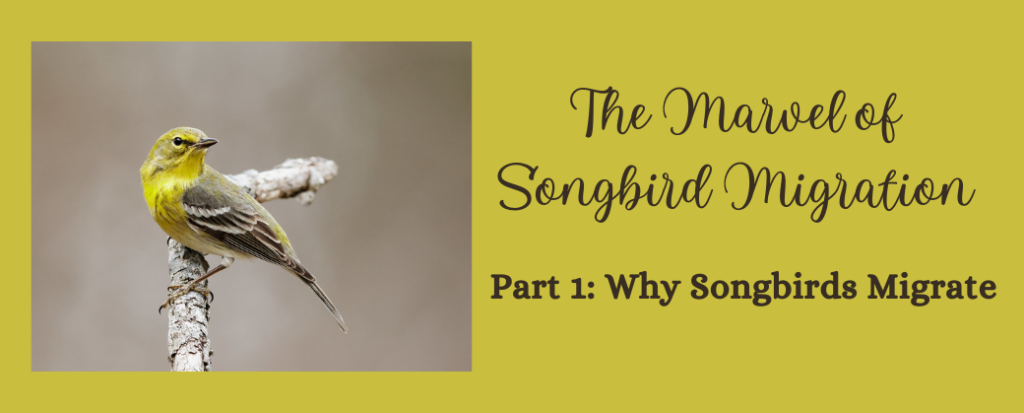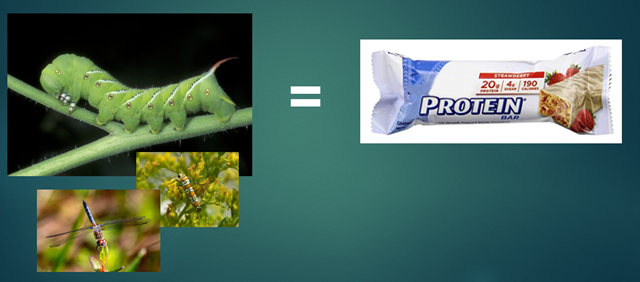The Birds Are Coming-Part 1
- ACLT American Chestnut Land Trust
- Apr 8, 2022
- 4 min read
Part 2 Now Available Click to Read

By Judy Ferris, Master Naturalist and Guest Blogger
Though it may be cold and windy outside as you read this, rest assured that a springtime surge of songbirds has already started moving northward. Most of our North American songbirds (warblers, sparrows, orioles, tanagers, and thrushes) head south for the winter.

Why would tiny songbirds, most of whom weigh less than an ounce, undertake such a perilous migration each year? It's all about insects. The timing of bird migration is tied to the springtime emergence of insect abundance which we experience here in North America.
Some species spend the winter only as far south as the southern U.S. Many species, however, are long-distance migrants; traveling to and from the Caribbean, Central America, and even South America. The average distance traveled by birds migrating from South America is about 1500 miles. Their journey may involve hop-scotching across the Caribbean to Florida or include a perilous 500-mile non-stop crossing of the Gulf of Mexico.

https://www.allaboutbirds.org/guide/Hooded_Warbler - Hooded Warbler singing. Not all Warblers warble!
Consider the following:
Pound for pound, insects contain 4 times as much protein as beef.
Insect organs are rich in fat - a far better energy source than carbohydrates.
Insects are the ideal fuel for migrating songbirds.
Insects are the baby food of choice for 96% of our songbirds.

Avian migration evolved about 15,000 years ago at the end of the last Ice Age. Many of our migratory warblers, sparrows, tanagers, and orioles evolved from tropical ancestors and have close cousins who live year round in the Caribbean, Central America, and even South America. The tropics have a high density of birds, so competition for nesting sites and food is intense. From an evolutionary standpoint, it was only a matter of time before independent-minded tropical birds broke with tradition and flew to the Florida or the Gulf Coast and beyond. What did they find? A cornucopia of insects and less competition for food and territory! While most tropical birds raise 2 or 3 chicks at a time, migratory birds who head north find enough insects to rear 5 or 6 chicks! The only drawback is that it gets cold in the north in the winter. So an autumn return trip to the tropics is a necessity. Migration is a risky undertaking and some birds are lost each year. In the end, however, both the tropical stay-at-home birds and the migratory birds successfully rear about the same number of offspring.
Our migratory songbirds evolved along with the plants, insects, and other wildlife that populated a North America unmarred by human activity. When these birds flew north from the tropics and reached our shores, they were greeted by pristine beaches and an endless green carpet of forests, grasslands, and wetlands which stretched from Florida to the boreal forests of northern Canada. For a hungry bird, this was a non-stop insect buffet. Stopovers for feeding, drinking, and resting were literally everywhere.


Birds today face a very different journey than that of their ancestors. Those previously pristine beaches are now lined with forests of tall condos. Vast tracts of woodlands have been eliminated. Replaced with shopping malls, subdivisions, and farmland. The wild places that remain are becoming so fragmented that they can no longer support wildlife - including insects.
Thus places like ACLT are increasingly precious. For birds who are just pausing in their journey, ACLT is a welcome rest stop. Like us humans, birds appreciate a good layover spot and will return year after year. Many migratory birds stay to breed and raise young at ACLT. This special place hosts a variety of breeding birds including indicator species such as Louisiana Waterthrush, Worm-eating Warbler, Scarlet Tanager, Kentucky Warbler, Wood Thrush, American Redstart, Prothonotary Warbler, and many others.
Other Resources
Calvert County is blessed with numerous areas to hike and explore. As you are out and about welcoming the arrival of spring, take time to pause, look, and listen. You may hear or see a bird that you never noticed before. If you take your binoculars with you, you may even have the privilege of observing these beautiful feathered creatures up close and personal. Be sure to check out the Calvert County Birding Trail link below to find additional areas to visit. Have fun and happy birding!

Calvert County Birding Trail - https://choosecalvert.com/birding
From ACLT's Website:
In 2006, ACLT member Leslie Starr completed 'Summer Birds of the Parker's Creek Watershed', as the capstone project toward a Certificate in Environmental Studies from the Johns Hopkins University School of Business and Professional Studies. The primary goal of the project was to obtain information on the occurrence and relative abundance of bird species found during summer in the watershed. Field work was conducted in summers 1999 and 2004, with particular emphasis on the various habitats of the watershed. Further study of lists of bird species of concern as documented by various bird conservation organizations, including National Audubon, the US Fish & Wildlife Service, and the Maryland Department of Natural Resources, revealed that thirty-three such species have been present in the watershed during summer, of which twenty-nine are known to be or are possibly breeding. Read more and search ACLT's bird database here.



Comments